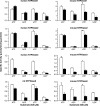Comparative hydrolysis of P2 receptor agonists by NTPDases 1, 2, 3 and 8
- PMID: 18404504
- PMCID: PMC2096530
- DOI: 10.1007/s11302-005-6217-x
Comparative hydrolysis of P2 receptor agonists by NTPDases 1, 2, 3 and 8
Erratum in
- Purinergic Signal. 2005 Jul 29;1(3):293
Abstract
Nucleoside triphosphate diphosphohydrolases 1, 2, 3 and 8 (NTPDases 1, 2, 3 and 8) are the dominant ectonucleotidases and thereby expected to play important roles in nucleotide signaling. Distinct biochemical characteristics of individual NTPDases should allow them to regulate P2 receptor activation differentially. Therefore, the biochemical and kinetic properties of these enzymes were compared. NTPDases 1, 2, 3 and 8 efficiently hydrolyzed ATP and UTP with K (m) values in the micromolar range, indicating that they should terminate the effects exerted by these nucleotide agonists at P2X(1-7) and P2Y(2,4,11) receptors. Since NTPDase1 does not allow accumulation of ADP, it should terminate the activation of P2Y(1,12,13) receptors far more efficiently than the other NTPDases. In contrast, NTPDases 2, 3 and 8 are expected to promote the activation of ADP specific receptors, because in the presence of ATP they produce a sustained (NTPDase2) or transient (NTPDases 3 and 8) accumulation of ADP. Interestingly, all plasma membrane NTPDases dephosphorylate UTP with a significant accumulation of UDP, favoring P2Y(6) receptor activation. NTPDases differ in divalent cation and pH dependence, although all are active in the pH range of 7.0-8.5. Various NTPDases may also distinctly affect formation of extracellular adenosine and therefore adenosine receptor-mediated responses, since they generate different amounts of the substrate (AMP) and inhibitor (ADP) of ecto-5'-nucleotidase, the rate limiting enzyme in the production of adenosine. Taken together, these data indicate that plasma membrane NTPDases hydrolyze nucleotides in a distinctive manner and may therefore differentially regulate P2 and adenosine receptor signaling.
Figures



Similar articles
-
Differential catalytic properties and vascular topography of murine nucleoside triphosphate diphosphohydrolase 1 (NTPDase1) and NTPDase2 have implications for thromboregulation.Blood. 2002 Apr 15;99(8):2801-9. doi: 10.1182/blood.v99.8.2801. Blood. 2002. PMID: 11929769
-
Regulation of P2Y1 receptor-mediated signaling by the ectonucleoside triphosphate diphosphohydrolase isozymes NTPDase1 and NTPDase2.Mol Pharmacol. 2005 Jan;67(1):114-22. doi: 10.1124/mol.104.006908. Epub 2004 Oct 20. Mol Pharmacol. 2005. PMID: 15496502
-
Coexpression of ecto-5'-nucleotidase/CD73 with specific NTPDases differentially regulates adenosine formation in the rat liver.Am J Physiol Gastrointest Liver Physiol. 2012 Feb 15;302(4):G447-59. doi: 10.1152/ajpgi.00165.2011. Epub 2011 Dec 1. Am J Physiol Gastrointest Liver Physiol. 2012. PMID: 22135310 Free PMC article.
-
Ectonucleotidases in Inflammation, Immunity, and Cancer.J Immunol. 2021 May 1;206(9):1983-1990. doi: 10.4049/jimmunol.2001342. J Immunol. 2021. PMID: 33879578 Free PMC article. Review.
-
Extracellular ATP and its derivatives provide spatiotemporal guidance for bone adaptation to wide spectrum of physical forces.Bone Rep. 2022 Aug 1;17:101608. doi: 10.1016/j.bonr.2022.101608. eCollection 2022 Dec. Bone Rep. 2022. PMID: 35992507 Free PMC article. Review.
Cited by
-
Ectonucleotidases in solid organ and allogeneic hematopoietic cell transplantation.J Biomed Biotechnol. 2012;2012:208204. doi: 10.1155/2012/208204. Epub 2012 Oct 16. J Biomed Biotechnol. 2012. PMID: 23125523 Free PMC article. Review.
-
Nucleotide Analog ARL67156 as a Lead Structure for the Development of CD39 and Dual CD39/CD73 Ectonucleotidase Inhibitors.Front Pharmacol. 2020 Sep 8;11:1294. doi: 10.3389/fphar.2020.01294. eCollection 2020. Front Pharmacol. 2020. PMID: 33013365 Free PMC article.
-
Activity and expression of ecto-nucleotide pyrophosphate/phosphodiesterases in a hepatic stellate cell line.Mol Cell Biochem. 2009 May;325(1-2):179-85. doi: 10.1007/s11010-009-0032-6. Epub 2009 Feb 5. Mol Cell Biochem. 2009. PMID: 19194664
-
Mechanosensitive Hydrolysis of ATP and ADP in Lamina Propria of the Murine Bladder by Membrane-Bound and Soluble Nucleotidases.Front Physiol. 2022 Jun 16;13:918100. doi: 10.3389/fphys.2022.918100. eCollection 2022. Front Physiol. 2022. PMID: 35784885 Free PMC article.
-
Ticlopidine in its prodrug form is a selective inhibitor of human NTPDase1.Mediators Inflamm. 2014;2014:547480. doi: 10.1155/2014/547480. Epub 2014 Aug 11. Mediators Inflamm. 2014. PMID: 25180024 Free PMC article.
References
Grants and funding
LinkOut - more resources
Full Text Sources
Other Literature Sources
Molecular Biology Databases
Research Materials

